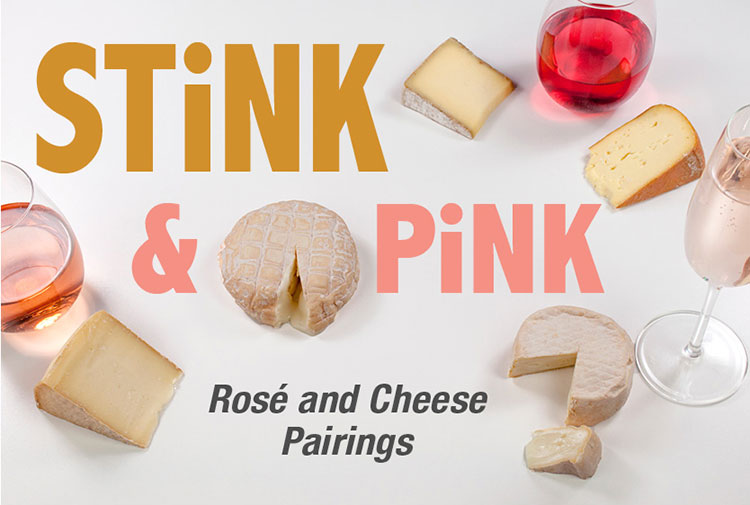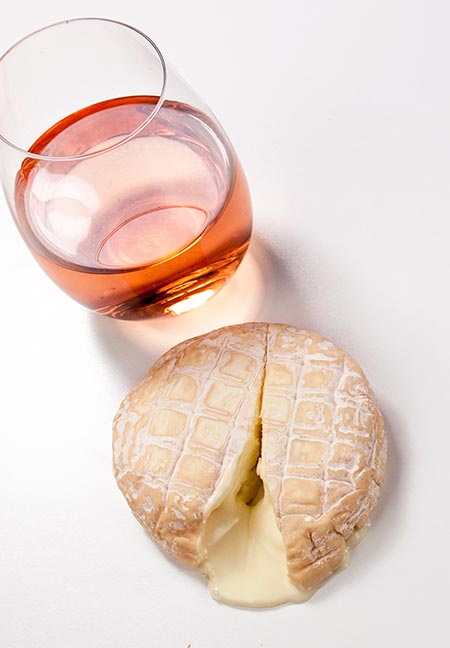A primer on funky, washed-rind cheeses that play ohhh-so-nice with Rosé wines

Written by certified cheese expert and sommelier Rachael Lucas
IN WASHINGTON STATE, the spring-and-summer season is synonymous with Rosé and the commencement of freshly bottled and newly released ambrosia. These blush-hued wines transport us from hefty, winter-leaning reds to refreshing pinks that go down like water on hot days. This interlude provides us with apt reason to delve into funky cheeses for the season—stink and pink play incredibly nice on the palate.
Complex, naturally
Stinky cheese couples well with Rosé for several reasons. First, since the cheese’s acidity levels are reduced by the brine, the crisp acid in the Rosé remains intact. High acid cheese and high acid wine tend to have a softening effect on each other, but in the case of a washy, the acidity in the wine continues to tingle on the palate and produce its signature salivary response.
Another reason for this celebrated pairing is that there tends to be a stark contrast in aromatics, which makes for an interesting combination. One tends to note an intentional emphasis on fruity esters and floral terpenes in the aromatic forefront of a Rosé, while the nuances in a typical washed rind are savory and funky.
Lastly, salt is wine’s friend. There is an undeniable saltiness that is paramount in a washed rind’s development. If you have any doubts, just bite into its rind—you will likely note a signature crunch because of its kippered effect. The cheese’s salt helps to bring out flavors in the Rosé, which makes for a more complex mouthful than either the Rosé or the cheese by itself.
Washington artisan cheesemaking is on the rise, and as such, there are an abundance of high quality, artisanal, stinky cheeses to pair with pink wines.
Glendale Shepherd’s Tallulah
At the top of the list is this lightly washed softy that is made with pasteurized ewe’s milk. Tallulah is clean—not at all farmy—a cottony mouthful, lactic, and biscuity in its flavor profile. It is made meticulously by hand in small batches, and it proves to be stunning with a variety of Rosés, ranging from light and spritely to something fuller and savory. Cheeses like this are rarities. Something similar and more readily available is Bossa from Green Dirt Farm in Missouri, yet at the same time very different, given breed, terroir, ambient microbes, and so forth.
Lost Peacock Creamery’s Curiosity
A new raw cow’s and goat’s milk mix-up, St. Pauline-style fromage with a blast of salinity and a good chew. This offers warm overtones with notes of toasted pepitas, baked sourdough, dried papaya, and brewer’s yeast. The exterior is subtly washed, which is curious in itself, considering the salt factor (she’s salty). The rind, however, looks almost like it formed naturally. Curiosity goes nicely with a Rosé with a touch of residual sugar, as that sweet/salty combo is satisfying on the palate. Look for a genuine St. Pauline Frenchie or seek out a firmer, mixed-milk washed rind with emphasized salt when replicating the experience.
Fantello Farmstead Creamery’s Filomena
This is a raw cow’s milk, raclette-style washed rind. Filomena has signature roasty-toasty, alpinal nuances that are umami-forward, herbal and nutty. A nuanced, well-structured cheese like this one deserves to be paired with a complex wine, otherwise the wine will get lost on the cheese’s constitution and aromatics. Try a pink made from a grape that possesses similar nuances—something herbal and complex, like a Rosé of Sangiovese or Rosé of Cabernet Franc. For a cheese alternative, look for a French raclette, such as Schmidhauser, an excellent choice if you can find it.
Cascadia Creamery’s Sawtooth
This raw cow’s milk is a stink bomb that is squidgy in texture, buttermilky, tart, luscious, cruciferous, and yeasty. This cheese likes fuller-bodied, pink ambrosia, and dang it, it deserves it! The mouthfeel is full and coating, so a lighter style Rosé will get lost on the cheese’s complexity. Go for something plush, like a 100% Rosé of Merlot with its summer fruit flavors (or even a Tavel Rosé from France) which will stand up well to the cheese without giving it too much sass. Other, more ubiquitous cheese options for Sawtooth are Taleggio (go for a smaller production one), and Jasper Hill’s Oma from Vermont.
Tieton Farm & Creamery’s Rheba
Made from pasteurized goat and sheep’s milk, this cheese is a direct expression of its unique terroir, much like a European, raw milk, soft stinker. Rheba freaks the funk, folks. She is odiferous and caprine with notes of dry hay, and she softens into a pool on your plate. Rosé of Pinot Noir bubbles pairs perfectly. Other cheeses with similar profiles are Old Worldly; for an alternative, try Alsatian Meunster or something with an equal level of stank and substance. This is another cheese that can benefit from a tick of residual sugar, and she needs a piercingly acidic wine in order to cut through the cheese’s slick mouth-coating layer.
How Washed Rinds Get Their Stinky Aromas & Earthen Colors

By Rachael Lucas
The “stinky” genre of fromage is a non-technical category that keeps washed-rind cheese on the front lines. Washed rinds get a special treatment during their aging process. Their exteriors are rubbed down repeatedly with a salt brine and/or an alcohol solution, which raises salt levels on the surface, reduces acidities, and provokes a lot of other mind-boggling, microbial stuff to occur.
This process of washing the rind creates a hospitable environment for yeasts and bacteria to thrive, most notably Brevibacterium linens (B linens). B linens are an aerobic species of bacterium that form colonies on the surface of a washed cheese. These bacteria are reddish and orange in color, and they give washed rind cheeses their signature coral or russet hues.
A bi-product of B Linens colonization is a sulphuric note that emits savory, cruciferous-type aromatics (think roasted Brussels sprouts and boiled cabbage). You can glean venison stew, bacon drippings, roast beef, and countless other savory flavors and smells from this cheese genre. They also provide signature, moist-spot, human aromas, like sweaty feet, armpits, and breath, among other (use your imagination) anthropomorphic odors. These human smells wafting from our washed rinds are, in fact, the same bacteria that we emit from our bodies. Now don’t you feel closer to your fromage?!
